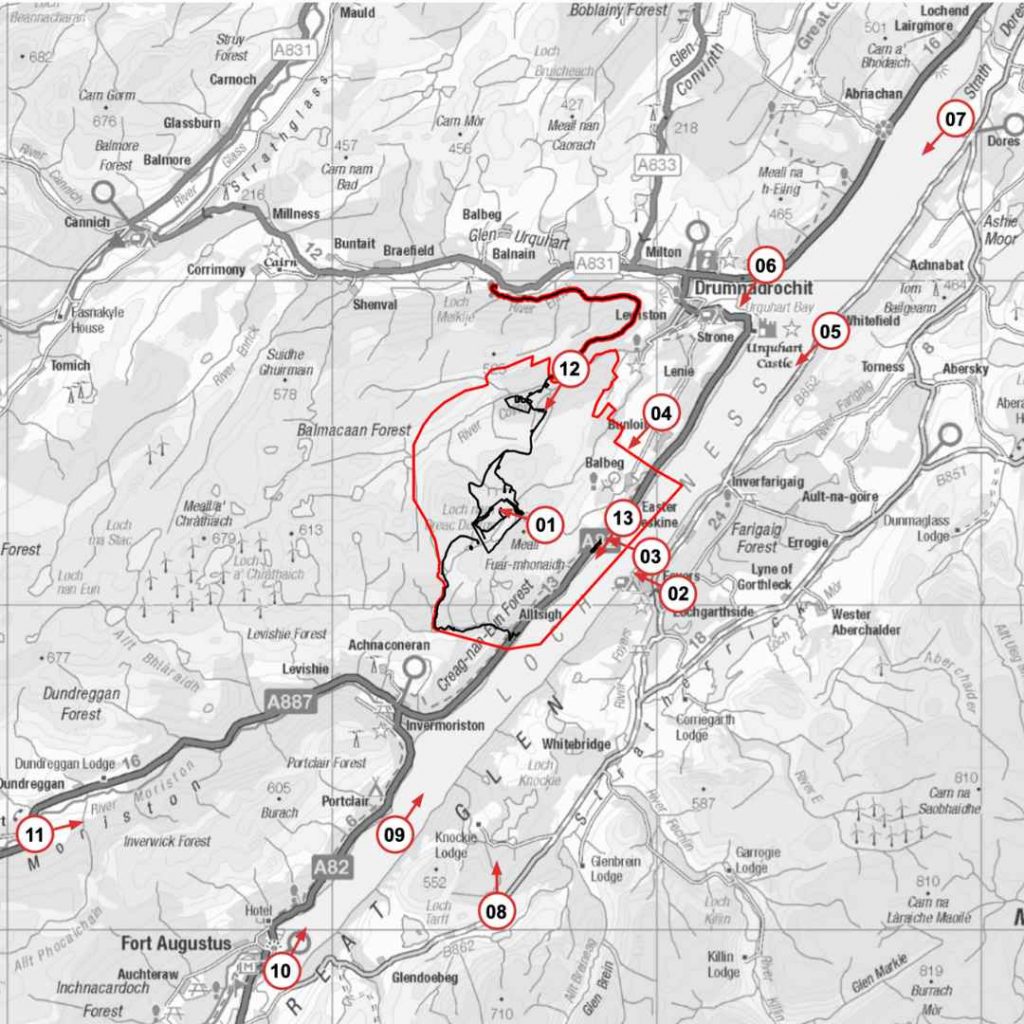Why are we concerned?
The Environmental Impact Assessment (EIA) submitted by Glen Earrach Energy has already highlighted a number of issues and ‘material considerations’, in terms of known constraints or lack of compliance with current planning policies, both nationally and within the Highlands.
Save Loch Ness is working with a number of professionals to review the EIA chapters and other technical information submitted in support of the application – this is a huge and ongoing task.
An initial summary of known issues and concerns is outlined below, but this list will no doubt grow significantly – we welcome your thoughts and input.
People & Communities
There will be significant increase in people present within Glen Urquhart, with up to 1000 people working and living on site during the construction period (8 years). This will effectively double the population of Drumnadrochit, putting significant pressure on local facilities and services.
Those familiar with currently operational Foyers pumped storage hydro facility will be aware of the operational noise associated with a facility that is 6.5 times smaller than the one proposed at Glen Earrach, and the distance over which this can be heard. The EIA identifies a number of additional noise sources, such as: blasting and non-blasting vibration (day & night), construction noise and vibration, increased traffic noise, ground-borne vibration and operational noise and vibration.
Glenurquhart’s inhabitants have a very long history, dating back to the early saints, Picts, Vikings, and others. It is highly likely that many archaeological and historical sites have yet to be discovered and studied, and any present-day developments may impact these, as happened with the archaeological remains found in Drumnadrochit when some of the new houses were built.
Glenurquhart and the surrounding areas have produced artists and writers of national, international and global significance. Some were influenced by the stories and beauty of the loch, which will be changed by the proposed development.
Health & Wellbeing has not been considered at all. Multiple pollutants will increase from noise, light, dust, emissions, traffic amongst other factors.
The detrimental impact on the local economy and tourism has not been considered either.

Not enough water in Loch Ness
During an abstraction cycle Foyers PSH varies the level of Loch Ness by up to 9cm (3.5”), Red John will have a similar effect, and the cumulative effect if the proposed, and much larger, Loch Kemp scheme gets the go-ahead, is a daily drawdown of up to 73cm (2ft 5in). The proposed Glen Earrach scheme would be the largest of all with a potential drawdown of 52cm (1ft 8in). The combined drawdown could be as high as 1.25m. Whilst this sounds like a small change for Scotlands second deepest loch, it relies on a fragile thermocline. It holds the Loch at a fairly steady 5º and this is why Loch Ness won’t freeze in winter, despite being the UK’s largest source of fresh, drinkable water. With the proposed developments effectively making Loch Ness tidal, the possible effects aren’t understood yet.
This would also have a huge impact on flows down the River Ness, a detrimental impact of the shoreline ecology of Loch Ness, impoverishing the rich shoreline ecology, and add to the considerable navigational, and operational difficulties already experienced by commercial, rescue and recreational boat users on the loch.
Traffic
There will be large increases in traffic, particularly HGV traffic on key roads during the projects construction phase, which will last at least 5-8 years. These roads are lifeline roads both for local residents and the millions of tourists that travel these roads each year, with few or no alternatives. The heaviest traffic increases on a daily basis for HGV’s are forecasted on the following roads:
Milton
Strathnacro
Understanding Environmental Impact
The EIA highlights that here are a number of residual significant effects resulting from the Proposed Development. These relate to ornithology, landscape and visual effects, the water environment, climate and forestry.
It also states there will be significant adverse effects on biodiversity post-mitigation which are included below.
Buglife have highlighted a range of issues, including:
- Inadequate assessment of impacts on terrestrial invertebrates
- Insufficient mitigation for terrestrial invertebrates
- Inadequate invertebrate surveys of aquatic macroinvertebrates in Loch Ness
- Inappropriate assessment of aquatic macroinvertebrates for Loch Ness and Loch nam Breac Dearga
- Adverse impacts on aquatic macroinvertebrates in Loch Ness and Loch nam Breac Dirge
Climate & Geology
If unmitigated, land use change (affecting peat) is estimated to release, at worst, 128,499 tCO2e. In addition, the carbon lost from the degradation of the peat within the Headpond area is 174,040 tonnes of carbon dioxide equivalent (tCO2e). Total Pre-Construction and Enabling and Construction Phase emissions are estimated to account for 1,009,664 tCO2e. The operational emissions over the design life of the scheme (assumed to be 125 years) are estimated at 4,087,800 tCO2e.
Over 400,000 cubic metres of peat will be extracted across a quarter of the development site – this is a nationally/globally important habitat, and counter to current policy. The ground works will extract over 9.5 million cubic metres of rock in an area of significant seismic risk. For context, an earthquake was triggered on Loch Mhor on the southeastern side of Loch Ness in 1971 during construction of the (significantly smaller) Foyers pumped storage scheme.
Works on site and to the Headpond, will likely interrupt and /or pollute multiple private water supplies
Visual Impact
Multiple significant landscape effects are predicted during the construction phase. Loch Ness attracts hundreds of thousands of visitors each year and tourism is a vital part of the local and wider economy. Over half of the view points assessed will experience significant, adverse effects during construction. These include but are not limited to:
Foyers: Views from residential properties in the settlement of Foyers during construction would be significantly affected.
Recreational routes: This would include views from the Caledonia Way, Loch Ness 360 trail and South Loch Ness trail from Foyers.
Local walking paths and informal tracks: This would include parts of the Meall Fuar-mhonaidh Route, Glen Coiltie Walking Loop, Loch nam Breac Dearga Trail, route along the River Coiltie and the Affric Kintail Way.
Recreational watercraft: Users on parts of the Glen Coiltie Canoe Trail and users of watercraft on Loch Ness would experience significant effects during construction.
Summits: There would be significantly affected receptors at the Meall Fuar-mhonaidh summit during construction.
Local landmarks and viewpoints: There would be significantly affected receptors at local landmarks and viewpoints.
Many of the impacts would continue into the operational phase with visual impacts still anticipated to be present after year fifteen of operation (i.e. 23 years from when works commence).

